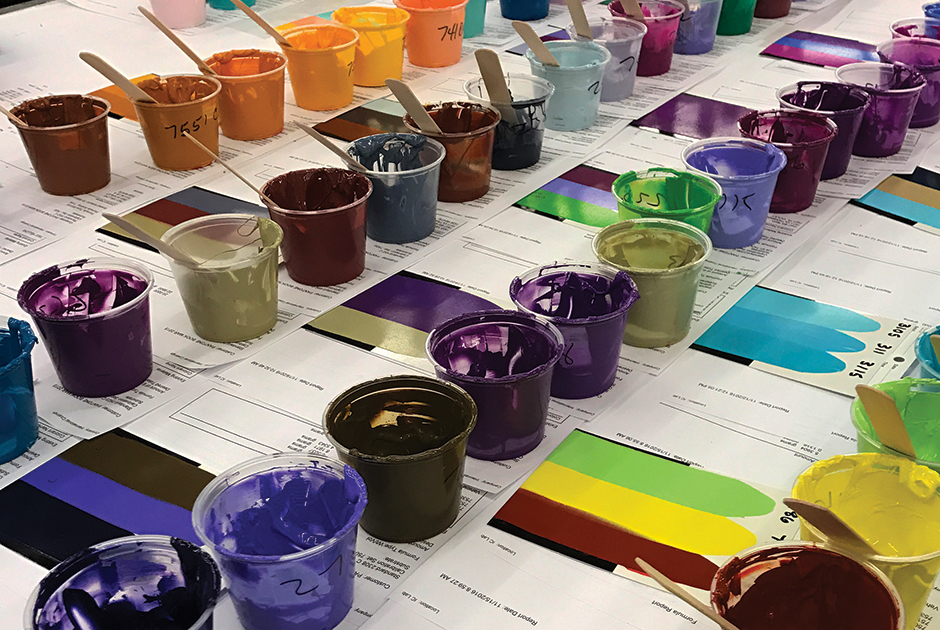Editor’s Note: The following article provides insight into how International Coatings uses its color-matching systems to match Pantone colors. This is only a snapshot of the process; it is not an endorsement of any system or mechanism used by International Coatings. Contact your ink supplier for specific details regarding its color-matching processes and systems.
How do you develop the most exact Pantone color matches? It’s not as easy as it seems and a lot of effort is involved. Most screen printers already know that Pantone is the main color standard used worldwide. The system consists of catalogs containing different shades of various colors.
Each color shade is identified with a unique number, often referred to as the Pantone or Pantone Matching System (PMS) color. Having such a standard makes it easy to reference a color exactly and eliminates mistakes or misunderstandings. For example, a customer’s “lavender blue” may not correspond to a printer’s idea of the same color. But when both parties are referencing Pantone 7451C, the chance that the printer’s color choice matches the customer’s color vision increases.
Best Practices
Colors also may look different when printed on various substrates, so the Pantone color catalogs are separated into coated (C), uncoated (U) and matte (M) guides to allow for as much accuracy as possible. Most printers use the coated or uncoated values, often to simulate either shiny plastisol (coated) or matte water-based (uncoated) inks.
It’s important not to match a color against an online color swatch. Each computer monitor is different and a color viewed on one monitor will be vastly different when viewed on another. Instead, invest in an actual Pantone catalog.
It’s not uncommon for customers to request that their designs be printed in specific colors. For example, some customers ask for their logos or art to be matched to specific Pantone colors. Rather than attempting to mix and match the ink colors on their own, printers can use a color-matching system.
For example, International Coatings offers a number of color-matching systems in its UltraMix line, most notably the 7500 Series color-mixing system. These systems consist of a number of “primary” colors that — when mixed according to a formula — will produce a fairly close Pantone color simulation.
The formulas for the company’s various color-mixing systems are published on its Formulation Calculator website (iccultramix.com). These formulas are specific to its color systems and would not work using other ink systems.
Formula Development
So how is a color formula developed at International Coatings? The staff starts by getting a new Pantone book every year and meticulously evaluating each color. Considering there are more than 1,867 existing colors, it’s a monumental task. To further complicate things, Pantone releases more than 100 new colors each March.
Aside from the sheer volume of colors, the techs also watch for shifts in the Pantone colors. Many screen printers don’t realize that colors in the Pantone booklets shift with age or exposure to harsh lighting or operating conditions. Therefore, it’s important to store the books in a protected environment and switch them out regularly for new ones.
In addition, Pantone’s “standard” colors often do not exactly match from year to year. This may be due to the printing process or changes in the paper on which the colors are printed. But colors from a book printed last year or a couple of years ago may be different from those in this year’s book. This may be true for only certain shades or colorways, but can present a significant shift, nevertheless.
To formulate the colors, International Coatings’ team starts by using a color spectrometer to “read” each color and give a basic starting formula. It then carefully weighs out the starting-point formula colors using the particular color-mixing series for which it is formulating. The sample goes for a ride in a centrifugal mixer that homogenizes the mixture.
Next, the staff creates a “drawdown” of the color, spreading the mixed color on a white and black Leneta card and curing it, and then looks at it in a light box using D65 (daylight) and CWF (cool white fluorescent) lighting.
Rarely is an exact match created only by using the color spectrometer. Each color must be adjusted to ensure it matches the Pantone chip as closely as possible. This requires an experienced color matcher and precise record keeping of the adjustments made, including what was added and the specific amounts. After each trial, another drawdown is made and examined.
Once the team thinks the Pantone color is true on the drawdown, a final test is performed to confirm the color match. A color matcher prints the mixed ink through a 110-mesh screen — in a single pass — onto a 50/50 polyester/cotton white garment. Once he confirms the exact match, he then checks the color sample for metamerism (a shift in the color’s appearance under different light sources) to ensure the formula is stable.
Though the color spectrometer is a great tool, it doesn’t beat the human eye for detecting color differences. Finally, experienced color matchers approve each color.
Even though the system may match the Pantone swatch as closely as possible, an exact match may not always be possible in printed form. There are many factors that can affect a print’s final color, including the type of substrate, curing temperature and time, and so forth. Communicate this to the customer in advance or, better yet, show him a test print for approval.
Mark Brouillard, International Coatings’ product manager, has considerable experience in formulating and manufacturing industrial compounds. For the past 16 years, his focus has been on the formulation and product development of textile screen-printing inks. Brouillard coordinates the company’s product development efforts and deployments. For more information, visit iccink.com or read the company’s blog at internationalcoatingsblog.com.





